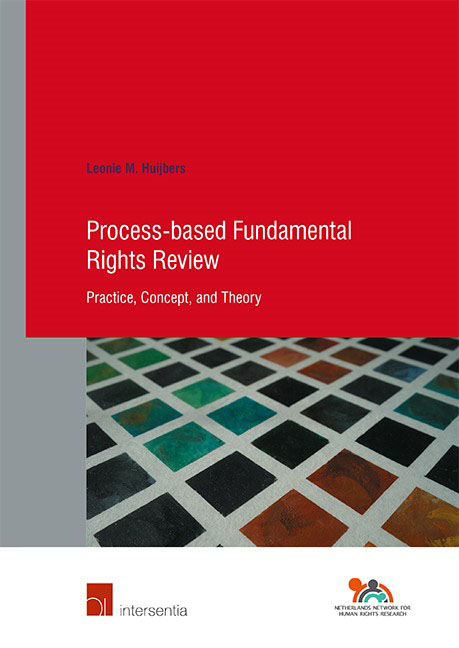Book contents
- Frontmatter
- Acknowledgments
- Contents
- List of Abbreviations
- INTRODUCTION
- PART I THE PRACTICE OF PROCESS-BASED FUNDAMENTAL RIGHTS REVIEW
- PART II THE CONCEPT OF PROCESS-BASED FUNDAMENTAL RIGHTS REVIEW
- PART III THE THEORY ON PROCESS-BASED FUNDAMENTAL RIGHTS REVIEW
- CONCLUSION
- Addendum: Questions for ECtHR Judges
- Summary
- Samenvatting
- Bibliography
- Official Documents
- Case-Law (by Jurisdiction)
- Case-Law (by Name)
- Curriculum vitae
- Human Rights Research Series
- Index
Chapter 8 - Debates Concerning Process-based Review and Procedural Mandates, Judicial Standard-setting, and Fundamental Rights Protection
Published online by Cambridge University Press: 11 November 2021
- Frontmatter
- Acknowledgments
- Contents
- List of Abbreviations
- INTRODUCTION
- PART I THE PRACTICE OF PROCESS-BASED FUNDAMENTAL RIGHTS REVIEW
- PART II THE CONCEPT OF PROCESS-BASED FUNDAMENTAL RIGHTS REVIEW
- PART III THE THEORY ON PROCESS-BASED FUNDAMENTAL RIGHTS REVIEW
- CONCLUSION
- Addendum: Questions for ECtHR Judges
- Summary
- Samenvatting
- Bibliography
- Official Documents
- Case-Law (by Jurisdiction)
- Case-Law (by Name)
- Curriculum vitae
- Human Rights Research Series
- Index
Summary
INTRODUCTION
Courts have an important task when it comes to the protection of fundamental rights. They are asked to interpret and apply fundamental rights in concrete cases. Through fundamental rights adjudication they not only clarify the meaning of these rights but also establish and show when fundamental rights have been violated. As so-called ‘ guardians of fundamental rights’, courts’ function can be said to be threefold: they have a duty to respect fundamental rights, to protect individuals and groups against interferences by other public authorities (or private entities), and to ensure their fulfilment by the other authorities. This function relates to a wide range of fundamental rights, including procedural and substantive rights, economic and civil rights as well as social, economic, and cultural rights, and individual and group rights.
As evidenced by the examples discussed in Part I of this book, in practice courts have relied on process-based review to determine if there was a justified interference with fundamental rights. This chapter addresses the debate on the use of procedural reasoning in light of the function of courts as guardians of fundamental rights. A large part of this chapter (Section 8.3) is therefore dedicated to the debate on whether procedural reasoning is an appropriate means for courts to carry out this task. To provide a basis for that debate, however, the chapter first addresses the broader question concerning courts’ overall function in democratic States (Section 8.2). This discussion covers issues of jurisdiction and of procedural mandate, and it deals with the question of whether and how courts may employ procedural reasoning to protect and develop procedural standards. Section 8.4 then connects and reflects on the various arguments discussed in these sections. In particular it addresses what is called the ‘ standard review loop’, that is, the circular relationship that is thought to exist between courts’ reviewing compliance with pre-existing standards and thereby refining and developing new standards that, in turn, inform future review on compliance with these standards. This section also addresses the various ways of perceiving the relationship between procedure and substance, the relevance of one's focus concerning the impact of fundamental rights adjudication, and the contextdependency of the effectiveness of a procedural approach. Section 8.5 concludes this chapter.
- Type
- Chapter
- Information
- Process-based Fundamental Rights ReviewPractice, Concept, and Theory, pp. 231 - 284Publisher: IntersentiaPrint publication year: 2021

